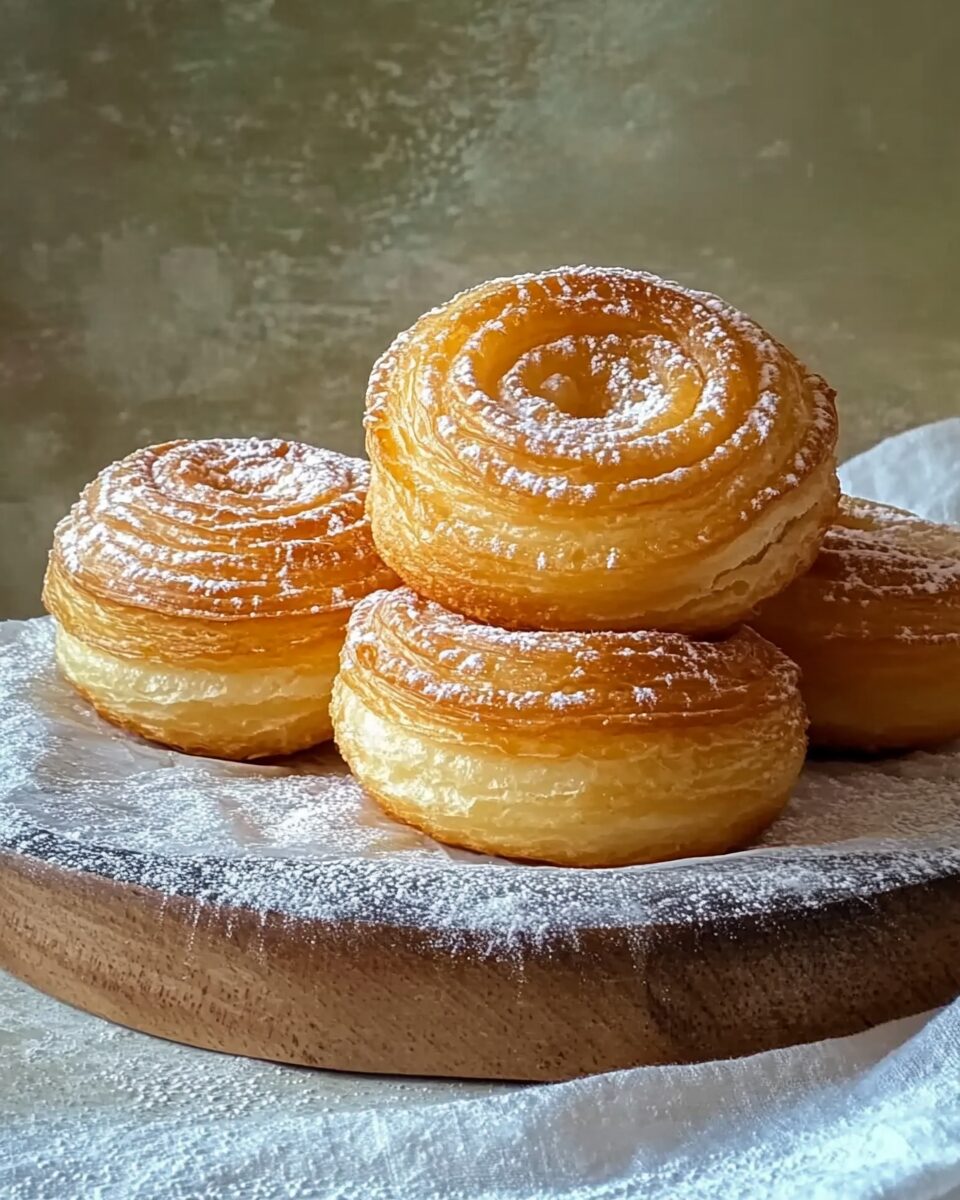Imagine the flakiness of a croissant combined with the delightful shape of a muffin—that’s a cruffin! These buttery, flaky pastries are perfect for breakfast, brunch, or an indulgent afternoon snack. With layers of laminated dough and a light dusting of sugar or a dollop of filling, cruffins are the ultimate pastry hybrid you didn’t know you needed.
Full Recipe:
Ingredients
-
Puff pastry (store-bought or homemade)
-
Butter (softened)
-
Granulated sugar or powdered sugar (optional)
-
Jam, cream, or custard for filling (optional)
Directions
-
Prepare the Dough
If using store-bought puff pastry, thaw it according to package instructions. Roll out the pastry into a thin rectangle on a floured surface. -
Butter and Roll
Spread softened butter evenly over the dough. Roll the pastry tightly into a log, then slice it into even sections, depending on the number of cruffins you’d like to make. -
Shape the Cruffins
Take each slice and gently stretch and twist it before placing it into a greased muffin tin. This creates the signature cruffin shape and helps the layers puff up beautifully. -
Bake to Perfection
Bake in a preheated oven at 375°F (190°C) for 20–25 minutes, or until golden brown and crispy. Let them cool slightly in the tin before transferring to a wire rack. -
Add the Finishing Touches
Dust with powdered sugar, roll in granulated sugar, or pipe in your favorite filling. Serve warm and enjoy!
Tip: For extra flakiness, chill the dough in the fridge after rolling and before slicing. Use a sharp knife or dental floss to slice the dough cleanly. Avoid overfilling to prevent the cruffins from collapsing.
Nutritional Facts
The nutritional content of cruffins can vary based on the specific ingredients and fillings used. On average, a plain cruffin made with puff pastry and butter contains approximately:
-
Calories: 250–300 kcal
-
Total Fat: 15–20g
-
Saturated Fat: 8–10g
-
-
Cholesterol: 20–30mg
-
Sodium: 200–300mg
-
Total Carbohydrates: 25–30g
-
Dietary Fiber: 1–2g
-
Sugars: 5–10g
-
-
Protein: 4–5g
The Origin of the Cruffin
The cruffin was first introduced in 2013 at Lune Croissanterie in Melbourne, Australia, by Kate Reid, a former aerospace engineer turned world-renowned pastry chef. Her background in precision and engineering carried over to her baking, where she meticulously worked on laminated dough to create pastries with perfect texture and structure. The idea behind the cruffin was simple yet genius: take croissant dough, roll it like a cinnamon roll, and bake it in a muffin tin. The result was a compact yet airy pastry, golden on the outside, soft and buttery on the inside, with swirling layers that beckon to be pulled apart and savored.
Not long after its debut in Australia, the cruffin made its way to the United States. In San Francisco, a bakery called Mr. Holmes Bakehouse popularized the cruffin stateside, offering new variations daily with fillings ranging from passionfruit curd to peanut butter mousse. Customers lined up for hours to get their hands on this new treat. Part of its early mystique was the secrecy surrounding its recipe; Mr. Holmes Bakehouse experienced a break-in where only the cruffin recipe book was stolen, sparking a wave of interest and intrigue.
Why the Cruffin Took Off
Several factors contributed to the cruffin’s meteoric rise. The visual appeal was certainly one of them. With its towering, spiral form and dusting of sugar or glaze, it was made for Instagram. But the cruffin is more than just a pretty pastry. It offers the layered complexity of a croissant with the comfort and portability of a muffin. This made it both luxurious and accessible.
The cruffin also arrived at a time when food hybrids were trending. The cronut—a croissant-doughnut mashup—had already taken New York by storm, paving the way for other experimental baked goods. Consumers were seeking novel experiences, and the cruffin delivered on all fronts: taste, texture, and trendiness.
Understanding the Art of Lamination
Central to the cruffin’s identity is its use of laminated dough. Lamination is the process of folding butter into dough multiple times to create thin layers. When baked, steam from the butter puffs the dough up, resulting in the distinct flaky texture found in croissants and puff pastry.
Versatility in Flavor and Filling
One of the cruffin’s most appealing qualities is its versatility. Unlike traditional croissants, which are often left unfilled or contain just one type of chocolate or almond paste, cruffins offer limitless possibilities when it comes to fillings and toppings.
Sweet Variations
Some of the most popular sweet cruffins feature fillings like lemon curd, chocolate ganache, vanilla pastry cream, caramel, cinnamon sugar, or berry compote. These are often injected into the center after baking or layered inside before rolling. Toppings like powdered sugar, glazes, or crumbled cookies further enhance their appeal.
Savory Variations
Savory cruffins are less common but equally delightful. These may include ingredients such as garlic butter, herbed cream cheese, bacon bits, sundried tomatoes, or cheese. A savory cruffin makes a great breakfast item or appetizer and can pair well with soups and salads.
Seasonal and Specialty Variants
During the holidays, bakers might create pumpkin spice cruffins in the fall, peppermint chocolate in the winter, or strawberry rhubarb in the spring. These themed varieties help keep the cruffin exciting and relevant year-round.
Cultural Significance
The cruffin isn’t just a pastry; it’s a cultural phenomenon. It reflects the current culinary era of innovation, where traditional boundaries are constantly being pushed and reimagined. The cruffin is emblematic of a larger movement in food culture—one that values creativity, visual presentation, and storytelling as much as taste.
Home Baking and DIY Cruffins
With the cruffin’s popularity came a surge in home baking attempts. At first, these were limited to experienced bakers familiar with laminated dough. However, as the demand for cruffins grew, simplified recipes emerged, using store-bought puff pastry to replicate the look and feel of a cruffin without the complexity.
The Future of Cruffins
Cruffins are here to stay, but their evolution is far from over. As more bakers explore the boundaries of this hybrid pastry, new versions will undoubtedly emerge. Vegan cruffins using plant-based butters, gluten-free variations made with alternative flours, and global flavors like matcha, miso caramel, or chai spice are just some of the directions the cruffin may take.
Conclusion
The cruffin stands at the intersection of tradition and innovation. By combining the timeless allure of croissants with the familiar form of muffins, it has created something wholly new yet comfortingly familiar. More than just a pastry, the cruffin represents the creativity, passion, and playfulness that define modern baking. Whether you’re picking one up at a local bakery or crafting your own at home, each bite is a celebration of texture, flavor, and imagination.






